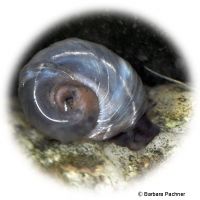Seminole Ramshorn Blue (Planorbella duryi)
| Seminole Ramshorn Blue Planorbella duryi | |
|---|---|
| Name | Seminole Ramshorn Blue |
| Name Lat. | Planorbella duryi |
| Family | Ramshorn Snails |
| Family lat. | Planorbidae |
| Order | Freshwater Limpets |
| Order lat. | Hygrophila |
| Origin | North America |
| Habitat | Streams, lakes, pools |
| Diet | Algae, detritus, snail food |
| pH | 6.5-8.0 |
| Behavior | Peaceful |
| Keeping | Individual, group |
| Care Level | Easy |
| Reproduction | Oviparous |
| Breeding | Simple |
| Life Span | 1-2 years |
| Protection | No |
| Metric Units | |
| Size | 2.5 cm |
| Temperature | 4-30 °C |
| Hardness | 10-20 °dH |
| Aquarium | ~ 20 l |
| US Units | |
| Size | 1" |
| Temperature | 39-86 °F |
| Hardness | 178-356 ppm |
| Aquarium | ~ 5 gal |
Distribution and habitat
The small blue ramshorn snail is a cultivated form. The wild form originates from Florida (USA). They live in stagnant and flowing waters, where they are mostly found on water plants, roots or stones
Maintenance
They need a well-structured aquarium, with plenty of aquatic plants, roots and stones. The substrate of sand or gravel should be partially covered with foliage (e.g. sea almond leaves, oak leaves), rotting plant material and mulm
The water quality must correspond to that for the average keeping of freshwater fish. No ammonia, ammonium and nitrite should be detectable in the water and the nitrate value should be below 100 mg/l. When using a filter, make sure that only a weak current is created and that no animals can be sucked in. The lighting must correspond to the natural day-night rhythm of the animals.
Diet
They feed on algae and residues of dead plants and animals (detritus). The food supply consists mainly of scalded leaves (lettuce, dandelion, etc.), food tablets with high vegetable content (spirulina) and nori algae leaves. Aquarium plants are usually not considered food. Unaccepted food must be siphoned off after 2-3 hours.
Regular and varied feeding promotes health and prevents deficiency symptoms.
Behaviour and compatibility
They can be well socialized with dwarf shrimp and fish, except for puffer fish and other species that pluck at the snails' antennae or consider snails food.
In principle, only mutually compatible species with similar requirements for water conditions and water temperature should be socialized.
Reproduction and breeding
They are hermaphrodites. During mating, they act either as males or females. Self-fertilization is also possible.
The clutches consist of a flat, oval-shaped jelly and are mainly attached to aquatic plants. Depending on the size of the snail, a clutch can be 5 mm in diameter and contain up to 30 eggs. The eggs are laid during the night. Depending on the water temperature, the young snails hatch about two to three weeks after egg laying.
Important
They are reddish brown to dark brown and are also grown in pink, white and yellow
Since young snails always leave the water, a distance of about 2 cm between the water surface and the edge of the aquarium should be maintained and the aquarium should be well covered
In the lung cavity there is a well supplied with blood skin flap as a substitute gill, which enables them to survive also in oxygen-poor waters. To build their shell, they need an adequate supply of lime. Especially in soft, acidic water, shell damage (holes) can occur due to calcium deficiency, which can lead to the death of the snail. Therefore, special attention should be paid to the calcium concentration in the water and, if necessary, calcium should be added in the form of limestone, cuttlebone or special preparations from the specialized trade
The foliage (sea almond tree, oak, beech, etc.) when rotting promotes the development of microorganisms, which are a valuable secondary food source.
The well-being of the animals should be checked regularly. Temperature should be checked daily, pH, hardness and nitrate levels at least every 14 days. Regular partial water changes are recommended, even when contaminant levels have not yet reached the upper limit. Sudden changes in water quality should be avoided. Newly introduced animals must be accustomed slowly to the water in the aquarium.
Further literature can be found in your pet store.
References
Text: Barbara Pachner; Image: Barbara Pachner
Source: BITTER (2008): Schnecken-Fibel, Dähne Verlag; ENGELMANN & LANGE (2011): Zootierhaltung - Tiere in menschlicher Obhut: Wirbellose, Verlag Harri Deutsch
